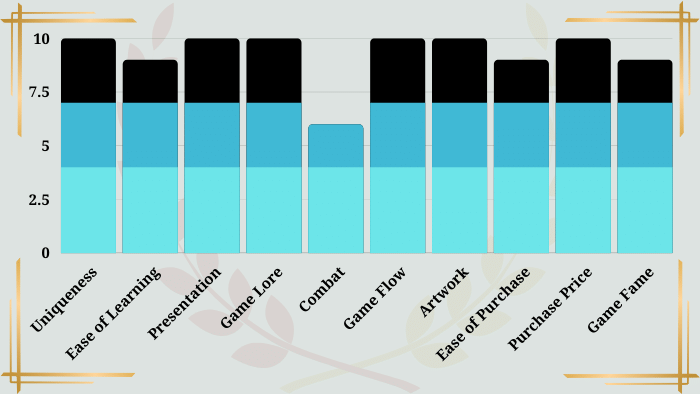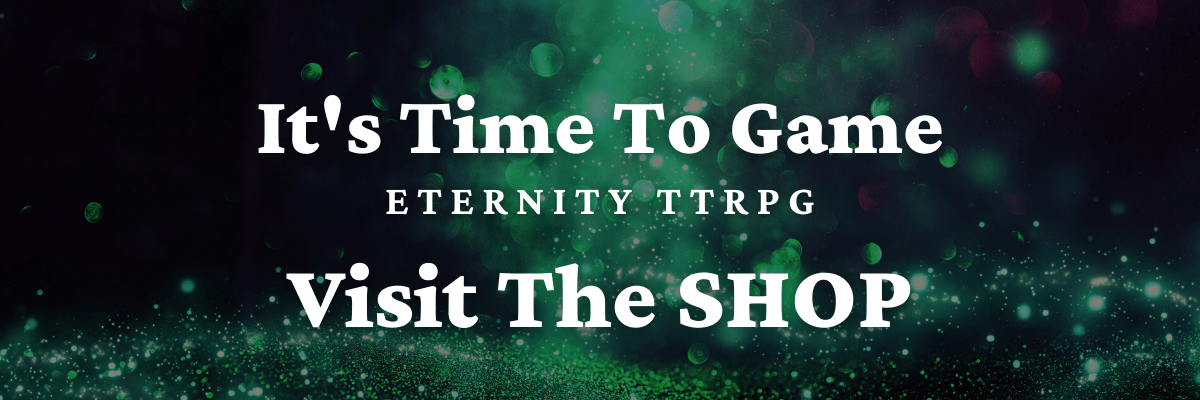Home > TTRPG Reviews
Cypher System
This Cypher System review is part of my “Best Tabletop RPGs of All Time” article. If you want to check out more TTRPGs and see how other top-tier tabletop RPGs are ranked, visit that page.
My Review – 93 / 100

It almost can't be said enough: Monte Cook is a genius and his games are amazing. He’s a legendary game designer and world builder, and is an absolute top-tier game designer. Of all his work, Numenera and the Cypher System, I believe, are his most well-known and celebrated.
To clear up one thing really quick: The Cypher System is a cross-genre tabletop RPG system. Numenera is a specific world with customized lore and stories that uses (basically) the Cypher System.
Just know that if you plan to buy Numenera or the Cypher System, that they are slightly separate games. One comes with a pre-existing world of lore (Numenera), while the other does not (Cypher System).
Uniqueness of the Cypher System: (10/10)
In the Cypher System, there are only three character stats. These stats represent a “Pool” of points from which you draw for abilities – and if you’d like – use extra effort to complete tasks or engage in combat by temporarily spending those points.
I normally like games with a bit more “depth” to them than three simple stats, but the way that Cypher System utilizes the stats is very unique. The game gets a lot of depth from might/ health, speed/ agility, and intellect/ personality. The simplicity is also a major plus for learning the system if you’re new to the game.
With each stat you also have an “Edge,” which is like a defense against spent points in the associated Pool, for extra effort. 1 edge reduces the cost of actions in that pool by 1. This system is very much like having “armor” against fatigue. It’s as if you’re reducing damage to yourself (your Pools), when increasing exertion for complex tasks.
When it comes to the Cypher System, the player always rolls, not the game master. To hit enemies, players roll against a static value. To dodge enemies, players roll defense against a static attack value. Target values are always based on difficulty of the task. In combat, target values are largely determined by the challenge rating of your enemy.
Players can use Experience points (Exp) to improve their character in a number of ways, to avoid additional story elements brought in by the game master, or to reroll skill or combat checks. When improving their character, players can improve stats, skills, effort, or edge. After improving all of them they go up a “Tier,” which is similar to “gaining a level” in most other TTRPGs.
Characters also gain a “Type” and a “Descriptor” which heavily influence stats and skills from the very start of the game. Types and descriptors are interesting way to broadly sort of make your own class, while giving players some starting roleplay ideas. They’re basically taglines for your character that help explain who your character is, and what they’re like in terms of personality, looks, demeanor, physique, etc.
Finally, characters also get a “Focus” which adds further unique elements to the character, such as “bears a halo of fire,” or “Explores Dark Places.” The Focus gives the player additional powers per character Tier.
Between your character’s type, descriptor, and focus, you essentially create your own character “class.” Otherwise though, and broadly speaking, Cypher System is a classless tabletop RPG.
When it comes to uniqueness, Cypher System is every bit as unique as Dungeons and Dragons was when it first came out.
Ease of Learning the Game: (9/10)
Learning to play the Cypher System is relatively simple. There are quite a few options at the start of the game when creating your character, but as you get familiarized with all the basic terminology, character-building, and the game overall, becomes very simple.
Because there are no character “classes” in Cypher System, and you essentially build your own when you choose your character’s type, descriptor, and focus, you end up reading through a lot of options when building your character. After all, your choices at the start of the game make a very large difference for your character’s overall progression through the rest of the game.
As I mentioned above though, what really simplifies the game and makes it great, starting a new character, is that each player really only has to think about 3 stats. Beyond that, everything really is just bonuses.
You can build a character in Numenera/ Cypher System much faster than you can in most tabletop RPGs. Whereas in other games you might spend 45minutes to an hour creating a character for your RPG campaign, with Cypher System, you might only spend 20-30 minutes.
Personally, I also feel that it’s easier to teach new players how Numenera/ Cypher System works than it is to teach them even Dungeons and Dragons. In reality, Cypher System is much simpler than DnD, yet still retains great game depth and options for character customization and progression.
Finally, the math in Cypher System is very simple. There’s a few intricacies here and there, but nothing that’s at all overwhelming, like you find in other tabletop RPGs.
Numenera and Cypher System Presentation: (10/10)
Numenera and Cypher System feature a very easy-to-read game manual. The content is very clear, and instructions are very easy to follow. Even the font and color selection is on-point, making it very simple to reference important rules or sections of the book.
Game Lore: (10/10)
Cypher System obviously does not come with its own lore, really. Instead, it offers a wide variety of selections to its players so that they can play the game in just about any type of setting they’d like.
When it comes to Numenera though, the lore is extensive. Set far into the furthest future imaginable, technology and magic have become synonymous in many regards. The lore is edgy and cool. It hits important traditional points in fantasy/ sci-fi and tabletop RPG legend, while still drastically expanding and creating its own place.
It’s not often that you can find truly unique game settings, nowadays. Between video game RPGs, tabletop RPGs, books, and artwork, just about every conceivable angle to fantasy and sci-fi settings has been at least briefly visited. However, I will say that when you come to Numenera, you’ll find a setting that’s fresh for your imagination to explore.
Cypher System Combat: (6/10)
I like combat in Numenera/ Cypher System more than I do in most games. I don’t like it as much as in Dungeons and Dragons because I feel the simple numbers in this case (and relatively uninspiring combat options) aren’t really to my liking.
Because there are only three core stats in the Cypher System, you don’t get to really flex your strategy/ tactical muscles very much.
In combat, you mostly end up using abilities within just one of your three core stats. That means you just use one single edge and one single effort, as well. Obviously, you go with whatever stat, edge, and effort have the highest values. Meanwhile, your other two stats (and their edges and effort) get completely neglected.
If your character fails in their main pool (runs out of resource points), chances are that it’s time to run away from the fight. There’s no switching to other stat pools, changing your combat tactics, or finding a creative way to restore your main stat points to fight on, like with a second wind of sorts.
So, fights are a bit one-dimensional in my mind.
Combat is less a question of whether or not you’ll win, and more a question of when you’ll win or lose. Fights are not really a matter of tactics and overcoming your enemy’s strategy so much as it is a matter of stat points, Pools, and Edges.
All that being said, as relatively uninspired as the tactical options provide for players, I do still moderately enjoy the feel of Cypher system combat. Fights feel a lot more complex than they actually are, and it does appear like what you do in combat is meaningful, even though that isn’t really the case.
Game “Flow”: (10/10)
Numenera/ Cypher System is more rules-light than other tabletop RPGs, but still with enough framework to really give you something to hold onto. To me, Cypher System actually has the ideal amount of rules for a good flow state. I always really enjoy playing Numenera/ Cypher System.
When playing, you won’t feel like you often have to reference the rules. Dice rolls are relatively simple, and quick. Your character provides you with just enough material to work with when roleplaying, through your type, descriptor, and focus.
Ultimately, the game is great at getting out of its own way, and at letting players just play.
Numenera and Cypher System Artwork: (10/10)
The artwork looks great. It’s uniform, fits the mood, and is dynamic. Top marks.
Cypher System artwork covers are lot of genres, as the game can be played in many settings. Meanwhile, the artwork for Numenera emphasizes the uniqueness of the setting: you get technology, magic, mystery, and drama.
If you haven’t seen the artwork of either game, and you enjoy fantasy/ sci-fi work, I highly recommend checking it out. I think you’ll find that the art present in Monte Cook’s games are every bit as high-quality and engaging as anything you’d find in a DnD core rulebook.
Ease of Purchase: (9/10)
The Monte Cook Games website is pretty good when it comes to site navigation, and purchase for the rulebook you’re after.
Monte Cook games can also be found on Amazon.
Price & How Many Books Do You Need to Play: (10/10)
To play Cypher System, you need just one core rulebook that goes for $23 as a PDF. If you want a printed version, you’re looking at $70, which still isn’t bad as the print quality is very high.
Numenera can be purchased as a started set for $25, or prices range from $20 for a core rulebook PDF, to $120 for a sort of collector’s edition that comes with two different core rulebooks.
Overall, when it comes to tabletop RPGs, I think the value that Monte Cook provides is top-notch. I like the diversity of pricing options that range from those on a budget, to collectors.
Fame & Availability of Supplemental Material: (9/10)
Surprisingly, many people are not extremely familiar with Numenera or Cypher System. Both games are quite popular in the hardcore tabletop gaming community. Many casual gamers have most likely heard of at least Cypher System, most have not played.
Still, if you’re looking to start up a game of Numenera or Cypher System, it does help that most people are at least familiar with the names.
Both games/ settings come with lots of supplemental material. If you wanted to start up a Numenera or Cypher System campaign, it’d be pretty easy for you to do so.
Numenera and Cypher System are Produced By:







